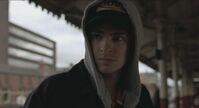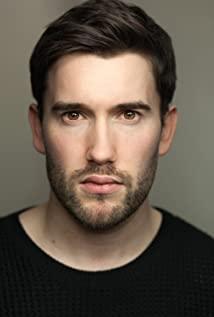When the movie started 5 minutes later, I had a kind of expectation: the movie is how the hero completes his self-redemption and how to become a brand-new JACK. When Jack in the movie shot kept walking through the aisle, when the memories gradually approached him and beckoned him, he was actually the lonely Eric who was longing for love.
When the movie first started, seeing Jack's innocent smile, I think most people couldn't believe he was a murderer. This brings the audience a very strong suspense and appreciation. Everything seems promising at the beginning of the movie, right from the conversation between Jack and Terry, the light from the window of the room under a panoramic shot seems to herald Jack's new life, and Terry's gift to him: those shoes, shoes are obviously a new beginning metaphor. Well, a backlit shadow shot of Terry in this conversation doesn't seem so simple.
In the many conversations between Terry and Jack, Terry repeatedly emphasized to Jack that he kept advising him that: forget your past, you are no longer the murderer, not Eric, you are another person Jack. But Jack couldn't forget, and even had a verbal conflict with Terry because he asked to see Philip's grave. Memories kept flashing in Jack's own mind. That is, it can be seen as another narrative thread we see.
Let’s start with a set of shots that Jack recalls. Jack is separated and lonely under the shot before Philip appears. In his class, a wide-angle shot completely separates Jack from his classmates. There is also a set of shots under the wall after school. And then Jack came home completely alone and lacking love. Even in the footage that Jack recalled, his father's face never appeared. The only thing that saw his father was a wide-angle shot. The lower half of his body, with a cigarette in his hand and wine in the foreground, was in the foreground. And Jack (Eric) is in the background. And when Jack (Eric) ran up to see his mother, they were placed in the foreground and background in the picture. Even if Jack (Eric) was beaten, no one cared about him. Through the concise picture language, Jack is also uncaring at home. Next is the appearance of Philip. It is worth noting here that there is a statue of a saint behind Jack (Eric), and the appearance of Philip seems to imply a change in Jack (Eric)'s lonely life. Save, he is no longer alone.
Going back to this line of Jack's reality, everything seems to be going in a good direction, meeting new friends, saving a little girl's life, and even getting a girlfriend, friendship and love. But Jack has been struggling with his memories, trying to hide his past self. There is a group of shots where Jack met his friend Chris and walked in an aisle surrounded by goods. The camera progressed with the conversation, and then passed through the aisle to the past. The camera switched to Jack's memory: Jack (Eric) and Philip were walking in In the aisle of a shipping container, Philip stepped forward when the other guys tried to bully Jack. In a scene where Philip kicked and beat, the director processed the sound and added a rumbling noise similar to a train, which made people feel a strong sense of unease. This expressed sense of unease seems to come from the current Jack, and the son At the same time, Jack (Eric) also participated in it under his guidance. At this moment, he seems to be comforted, even happy. He is no longer alone and even has friends to protect him. The aisle is not only a metaphor for going back to the past, there are many scenes of Jack walking in the aisle in many scenes that follow. Giving a metaphor is that Jack seems to be constantly looking for a way out in the aisles, constantly escaping his memories. One of the group's long shots of walking down the aisle looking for Chric but eventually finding it, gives a strong sense of oppression. There is also a group of shots of Jack walking in the aisle after escaping from the roof at the end. Jack walked in the aisle and passed two children. The two children here are obviously metaphors for him and Philip, and then there are memories. appear. Here the aisle once again plays the role of connecting the past. In his memories, Philip dragged the girl under the bridge to kill him, and kept calling Jack (Eric) to help. Underneath the bridge in the shot seems to be a hole, and it is pitch black. Jack (Eric) entered this dark abyss with a knife for his only friend. After the shot shows Jack (Eric) entering the bottom of the bridge, the next shot is the real Jack coming out of a hole. This naturally heralds the end of the memory and Jack finally finding his own way, finally letting go and finally daring to face his past. Finally, he came to the playground by the sea with the railway, and the camera was full of sunshine. Jack, who kept searching in the aisles, finally found a way out. In a long shot of going to the beach, there are the laughter of a group of children playing, the vocal music of the playground, and the appearance of lovers. Everything seems to represent Jack's new life. finally when He finally smiled when he took out the little girl's letter. As the little girl wrote: You are an angel.
Terry in the movie is a very important point. I always thought that as long as I forget the past, I can start over. He was clearly wrong. Jack proved him wrong with his life. Therefore, he is a loser in life. He divorced and lost his son at an early age. In the end, his son could not forgive him when he came back. He poured his life into Jack completely, forgetting everything about himself.
The whole movie is quite smooth, the graphics are simple, and the scene scheduling is very good. Especially the use of depth-of-field lenses, and the blurring of many front and rear backgrounds. Then there is the use of long shots, which I really liked, the long shot where Jack (Eric) and Philip were lying on the grass talking and the one where Jack wanted to take a photo with Chris. There is also the simplification of the lens, and many things are omitted. Such as: When Jack went to the office to invite his girlfriend to a movie, the simplification of the part she promised. It seems simple to deal with, but let the audience slowly participate in the thinking with the movie.
There is also a more important scene is the scene of the party. Under the influence of alcohol and drugs, I finally bravely confessed to Michelle, and I really like the dance that Jack danced. Jack finally exposed his true self under the influence of alcohol and drugs. Especially when his friend Chris was beaten up like a crazy beast to help him. He was so similar to Philip at this time. He's so crazy because he's so afraid of being alone, he needs love, he needs friends, so he's desperate for friends. He even attacked the girl for his only friend, Philip. He had no choice. He's just a child longing for love.
View more about Boy A reviews











